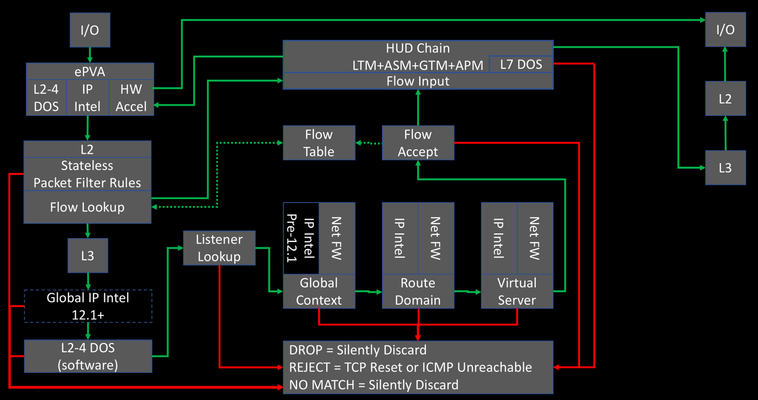packet capture
5 TopicsTLS1.3 Decryption
Hello all, any idea if this is supposed to work for tls1.3 ? https://clouddocs.f5.com/training/community/adc/html/class4/module1/lab10.html This approach was very simple and used to work fine for tls1.2. I just found this article for tls1.3 https://my.f5.com/manage/s/article/K36120659 ThanksSolved92Views0likes1CommentPacket Tracing in BIG-IP AFM
New in the v13 release of the BIG-IP Advanced Firewall Manager is the capability to insert a packet trace into the internal flow so you can analyze what component within the system is allowing or blocking packets based on your configuration of features and rule sets. If you recall from our Lightboard Lesson on the BIG-IP Life of a Packet, the packet flow diagram looks like this: The packet tracing is inserted at L3 immediately prior to the Global IP intelligence. Because it is after the L2 section, this means that a) we cannot capture in tcpdump so we can’t see them in flight and b) no physical layer details will matter as it relates to testing. That said, it’s incredibly useful for what is and is not allowing your packets through. You can insert tcp, udp, sctp, and icmp packets, with a limited set of (appropriate to each protocol) attributes for each. To get to the packet trace utility in the GUI, navigate to Network->Network Security->Packet Tester as show below. Note: In v13.1 this feature has been moved to Security -> Debug -> Packet Tester. This will launch the packet testing tool as shown here: Note with this tcp selection, in addition to setting the flags, you can configure the source and destination ip/port, source vlan, and trace options as it relates to policy and logging. An example packet trace shows the output of the trace after it completes: You’ll notice here that IP Intelligence and DoS have no beef with the packet, but there is no virtual match so the default action at the end of the path is to reject. Note that you can also use the packet trace utility in tmsh. The command is tmsh show net packet-tester security and results in an output like below. tmsh show net packet-tester security protocol tcp syn src-addr 192.168.101.2 src-port 21233 dst-addr 192.168.101.55 dst-port 8080 src-vlan external ************************* Packet Tester Data: ************************* Packet SrcIP/Port:192.168.101.2/21233 Src Vlan external Packet DstIP/Port:192.168.101.55/8080 Packet Protocol: tcp Packet Trace Option: Check Staged:Disable, Trigger Log:Disable Stage:Device-IP Intelligence Result: Default Stage:Device-DoS Result: Default Stage:Device-Access Control Result: Drop Stage:Route Domain-IP Intelligence (unset) Result: Default Stage:Route Domain-Access Control (unset) Result: Drop Stage:Listener-IP Intelligence (No Listener) Result: Default Stage:Listener-DoS (No Listener) Result: Default Stage:Listener-Access Control (No Listener) Result: Drop Stage:Device Default Result: Drop Final Result Packet SrcIP/Port:192.168.101.2/21233 Src Vlan external Packet DstIP/Port:192.168.101.55/8080 Packet Protocol: tcp Packet Trace Option: Check Staged:Disable, Trigger Log:Disable Stage:Device-Access Control Policy Name: unset Rule Name: unset Stage:Route Domain-Access Control Route Domain name: unset Policy Name: unset Rule Name: unset Stage:Listener-Access Control Listener name: unset Policy Name: unset Rule Name: unset Default Rule : No Device Default Rule Final Action : Drop Total records returned: 1 And because of tmsh, you can easily script packet generation with bash or even a tmsh script if you’re feeling the Tcl love. Current Limitations Only one packet can be inserted at a time, so even a scripted experience via tmsh will result in very low packets per second, which isn’t likely to really impact DoS for valid tests. Only valid headers are allowed, so a large part of typical red team attack vectors are not covered. No tcpdump visibility. No hardware paths. Basic visibility tools like the packet tester are great additions to the BIG-IP AFM. Whether it’s for testing new rules, validating existing ones, or simply throwing a bone over the fence to your operational security team to know where in your configuration an isolated action is being trapped, the v13 AFM packet tester has you covered!3.2KViews1like11CommentsDeleting .pcap files in "/var/tmp/"
Hello everyone! I'm running an HA pair of Big-IP units (BIG-IP 12.1.2 Build 0.0.249 Final) and I need to take packet captures now and then. I'm just wondering if it's safe to delete the capture files once I'm done, like from the CLI? Could I just [cd /var/tmp] and then [rm capturefile.pcap] ? Thanks!Solved1.7KViews0likes2CommentsHow to packet capture the whole traffic flow in VIP by Automap
Hi, I do have a VIP configured using Automap. 2 nodes on the pool member. Now, the problem is the log on the nodes member will always show the self IP as a source IP address. Configure X-forwarded will not work for my application due the the network setup. I try packet capture with command: tcpdump -ni 0.0:nnnp -s 0 host or port -w /var/tmp/test.pcap On Wireshark, if follow the TCP stream, it won't show the full traffic flow. It just either "self IP and node IP" or "actual source IP and VIP" How to capture/filter the packet so that I can have a full set of the traffic flow?1.2KViews0likes1Comment
